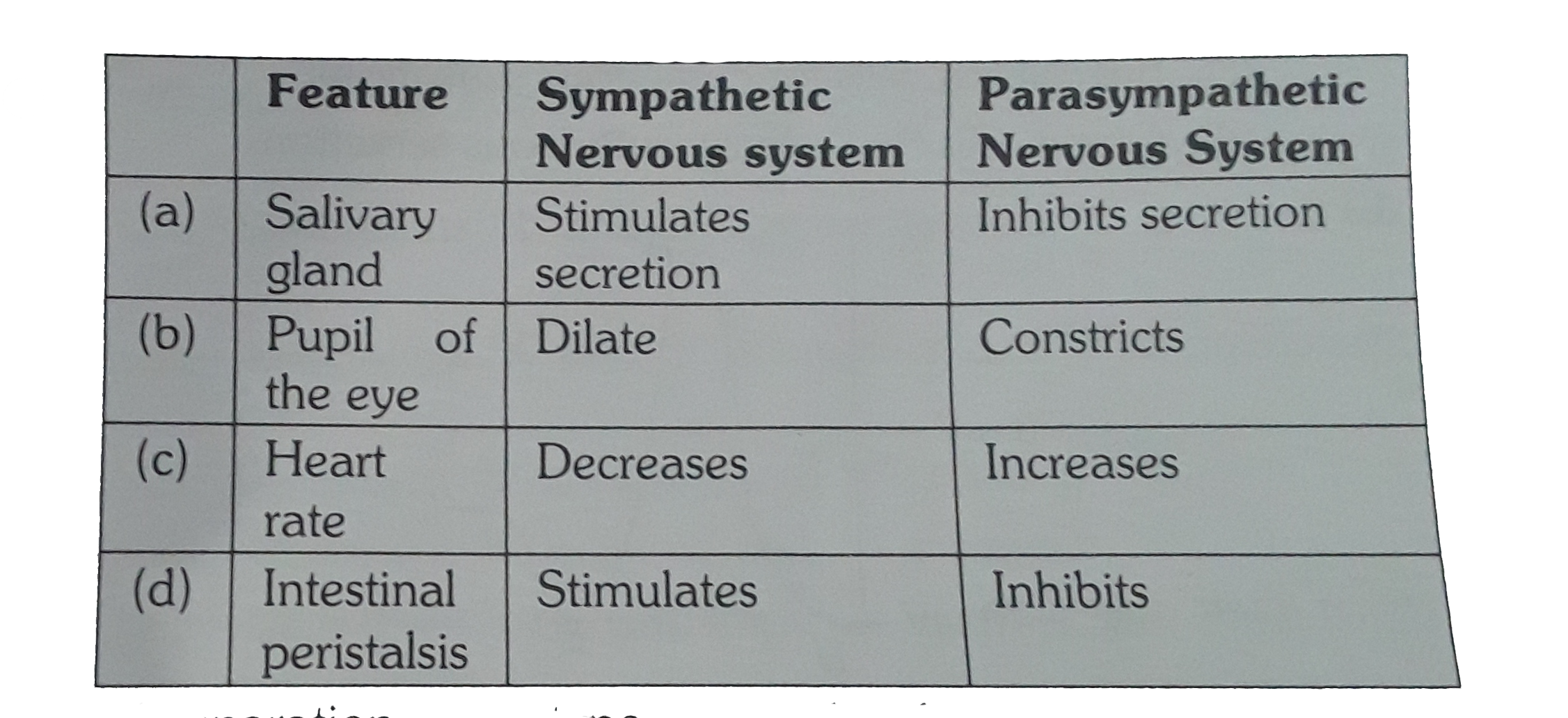Distinguish between Sympathetic and parasympathetic nervous system.
Step-by-Step Solution:
1. Definition of the Nervous System:
- The nervous system is divided into two main parts: the Central Nervous System (CNS) and the Peripheral Nervous System (PNS).
2. Peripheral Nervous System Division:
- The Peripheral Nervous System is further divided into the Somatic Nervous System and the Autonomic Nervous System.
3. Autonomic Nervous System:
- The Autonomic Nervous System is classified into two branches: the Sympathetic Nervous System and the Parasympathetic Nervous System.
4. Sympathetic Nervous System:
- The Sympathetic Nervous System is responsible for the "fight or flight" response. It prepares the body for stressful or emergency situations.
- It involves shorter neurons, leading to a faster response time.
- Physiological effects include increased heart rate, inhibition of saliva secretion, and a general state of heightened alertness.
5. Parasympathetic Nervous System:
- The Parasympathetic Nervous System is responsible for the "rest and digest" functions. It helps maintain homeostasis and promotes relaxation.
- It involves longer neurons, resulting in a slower response time.
- Physiological effects include decreased heart rate, increased saliva secretion, and enhanced digestion.
6. Comparison Table:
- Create a comparison table to clearly distinguish between the two systems:
| Feature | Sympathetic Nervous System | Parasympathetic Nervous System |
|----------------------------------|------------------------------------|------------------------------------|
| Function | Fight or flight response | Rest and digest response |
| Neuron Length | Shorter neurons | Longer neurons |
| Response Time | Faster response | Slower response |
| Heart Rate | Increased | Decreased |
| Saliva Secretion | Inhibited | Increased |
| Overall Effect | Prepares body for danger | Calms the body |
- The nervous system is divided into two main parts: the Central Nervous System (CNS) and the Peripheral Nervous System (PNS).
- The Peripheral Nervous System is further divided into the Somatic Nervous System and the Autonomic Nervous System.
- The Autonomic Nervous System is classified into two branches: the Sympathetic Nervous System and the Parasympathetic Nervous System.
- The Sympathetic Nervous System is responsible for the "fight or flight" response. It prepares the body for stressful or emergency situations.
- It involves shorter neurons, leading to a faster response time.
- Physiological effects include increased heart rate, inhibition of saliva secretion, and a general state of heightened alertness.
- The Parasympathetic Nervous System is responsible for the "rest and digest" functions. It helps maintain homeostasis and promotes relaxation.
- It involves longer neurons, resulting in a slower response time.
- Physiological effects include decreased heart rate, increased saliva secretion, and enhanced digestion.
- Create a comparison table to clearly distinguish between the two systems:
|----------------------------------|------------------------------------|------------------------------------|
| Function | Fight or flight response | Rest and digest response |
| Neuron Length | Shorter neurons | Longer neurons |
| Response Time | Faster response | Slower response |
| Heart Rate | Increased | Decreased |
| Saliva Secretion | Inhibited | Increased |
| Overall Effect | Prepares body for danger | Calms the body |
Topper's Solved these Questions
- QUESTION BANK 2021Book:NAVNEET PUBLICATION - MAHARASHTRA BOARDChapter:QUESTION BANK 2021Exercise:CHAPTER 10 (MCQ)
Explore 10 Videos
- QUESTION BANK 2021Book:NAVNEET PUBLICATION - MAHARASHTRA BOARDChapter:QUESTION BANK 2021Exercise:CHAPTER 10 (Single sentence answers)
Explore 10 Videos
- QUESTION BANK 2021Book:NAVNEET PUBLICATION - MAHARASHTRA BOARDChapter:QUESTION BANK 2021Exercise:CHAPTER 9 (3 marks)
Explore 7 Videos
- MULTIPLE CHOICE QUESTIONS Book:NAVNEET PUBLICATION - MAHARASHTRA BOARDChapter:MULTIPLE CHOICE QUESTIONS Exercise:Organisms and Environment -II
Explore 18 Videos
- SHORT ANSWER QUESTIONS -I Book:NAVNEET PUBLICATION - MAHARASHTRA BOARDChapter:SHORT ANSWER QUESTIONS -I Exercise:Chapter 19 : Organisms and Environment - II
Explore 7 Videos
Similar Questions
Given below is a table camparing the effect of sympathetic and parasympathetic nervous system for four features (a-d). Which one feature is correctly described

View SolutionAutonomic nervous system || sympathetic and parasympathectic nervous sytem || sense organ classification || skin receptors || olfactory receptors
View Solution
Knowledge Check
Given below is a table camparing the effect of sympathetic and parasympathetic nervous system for four features (a-d). Which one feature is correctly described
 ASalivary glands, stimulate secretion, inhibits secretionBpupil of the eye, dilates, constrictsCheart rate, decreases, increasesDintestinal peristalsis, stimulates, inhibits
ASalivary glands, stimulate secretion, inhibits secretionBpupil of the eye, dilates, constrictsCheart rate, decreases, increasesDintestinal peristalsis, stimulates, inhibitsAll of the following are under regulation of sympathetic and parasympathetic nervous systems except
AHeart rateBDigestive tract activityCLearningDMicturitionIn each of the following question a statement of assertion is given followed by corresponding statement of reason of the statement mark the correct
Assertion Iris muscles show both dilation as well as constriction of pupil
Reason [R] It is sympathetic and parasympathetic nervous system which have antagonistic functions.ABoth assertion and reason are true and reason is correct explanation of assertionBBoth assertion and reason are true and reason is not correct explanation of assertionCAssertion is false reason is trueDAssertion is true and reason is false
Which of the following is an incorrect match regarding effects of sympathetic and parasym pathetic nervous systems on different organs?
View SolutionGo through the following characterization of Sympathetic and Parasympathetic Nervous System.
I. Dilates pupul
II. ↑ Heart rate. ↑ BP (Vasoconstriction) ↑ Glycogenolysis, dilates bronchi
III. Constricts pupil
IV. Induces ejaculation
V. ↑ Gastric secretion, ↑ salivary secretion, ↑ peristalsis
VI. Erection and urination
View SolutionOn stimulation, sympathetic nervous system
View SolutionExtraction of sympathetic nervous system is
View SolutionOne function of parasympathetic nervous system is
View Solution